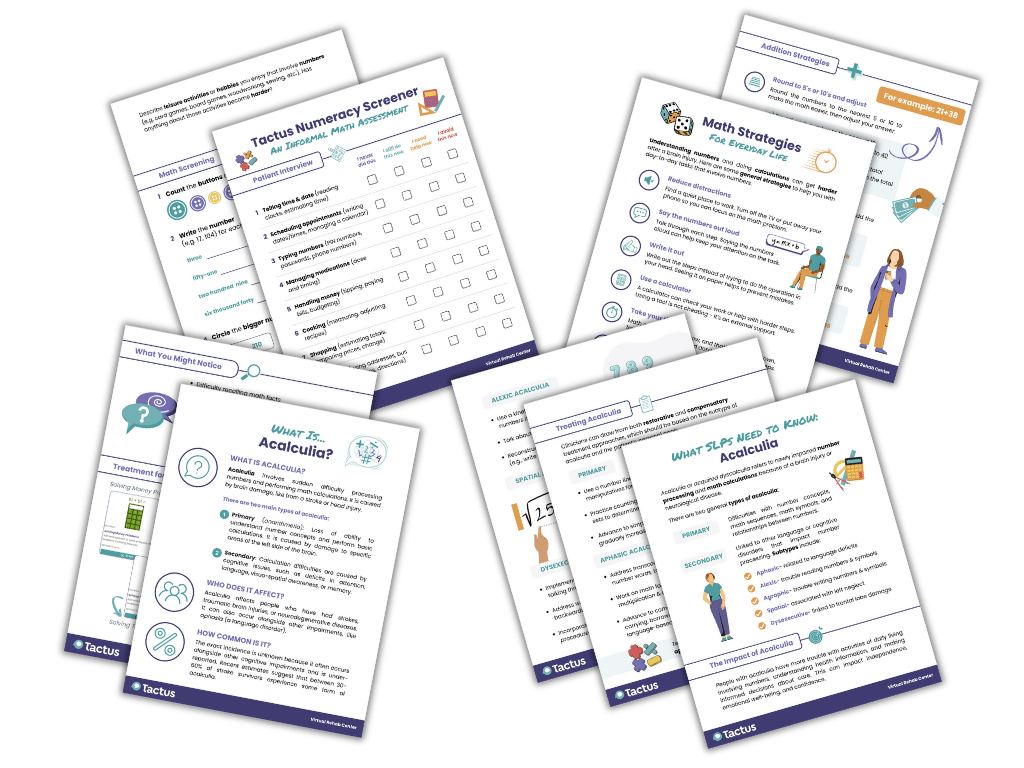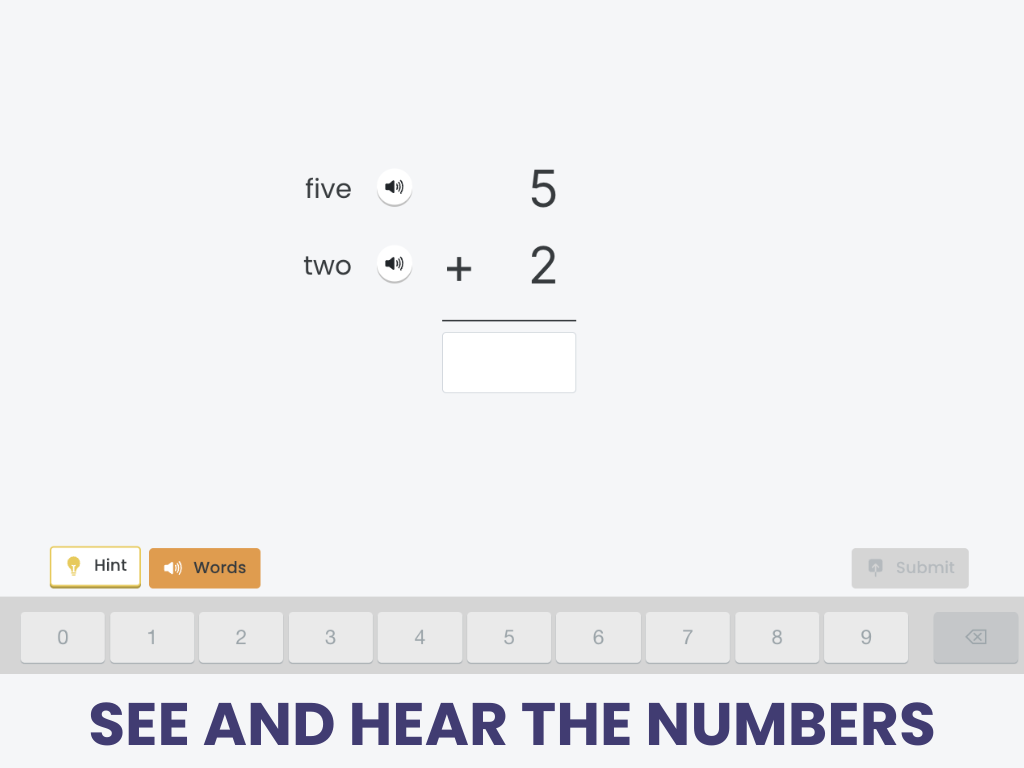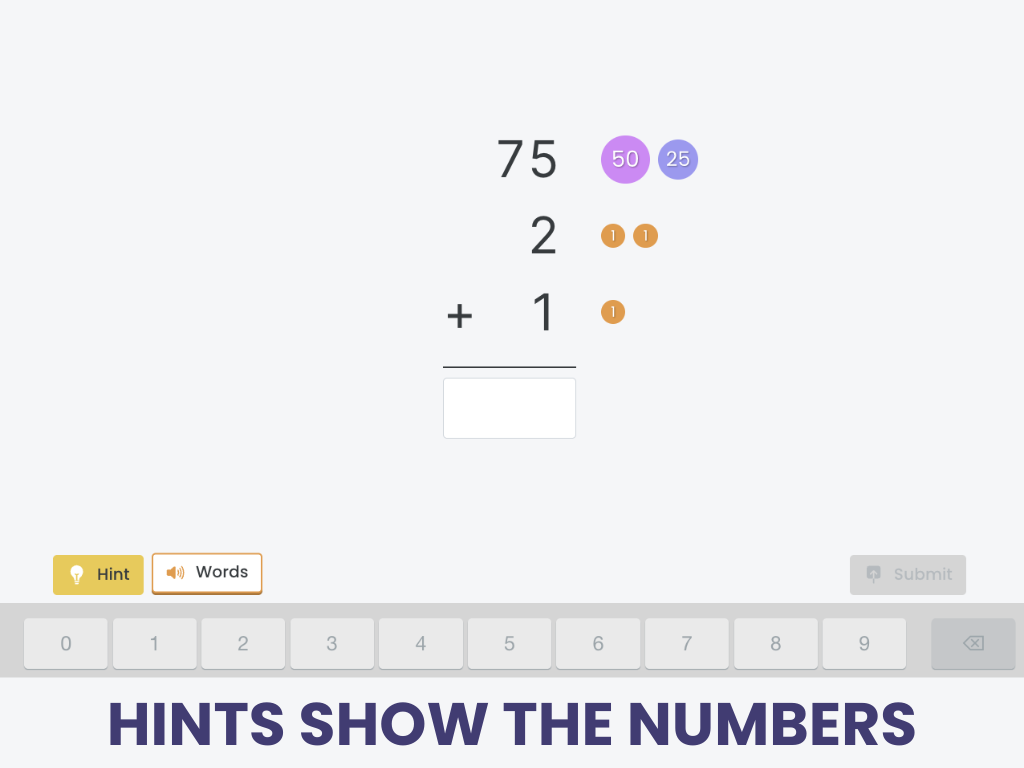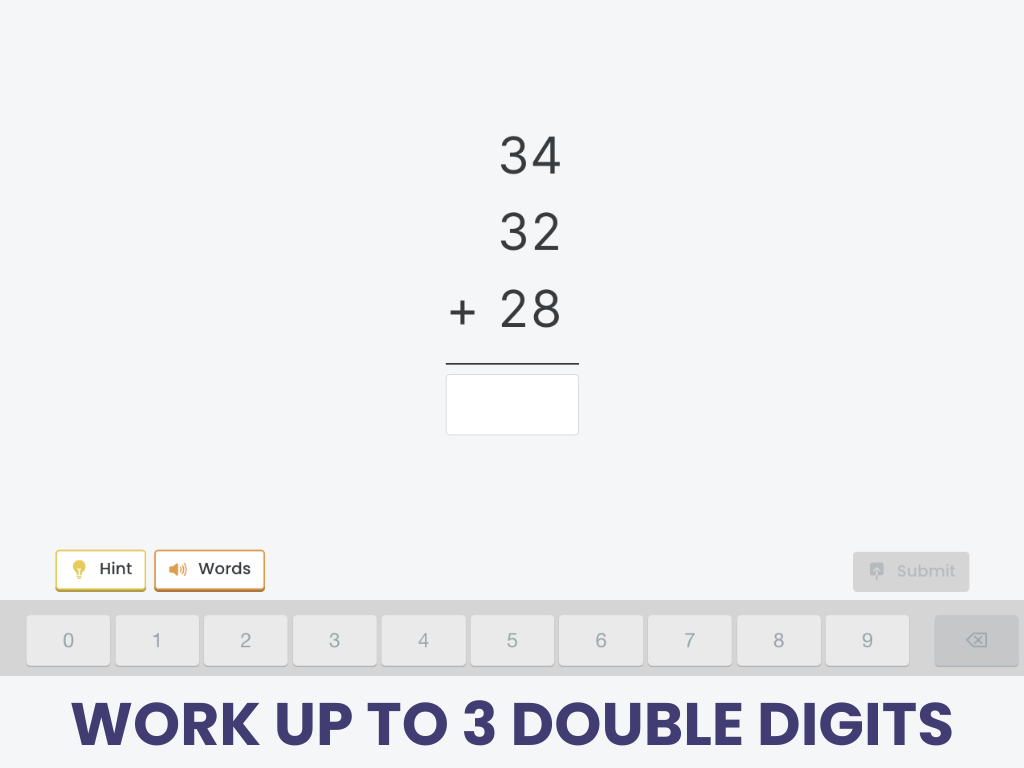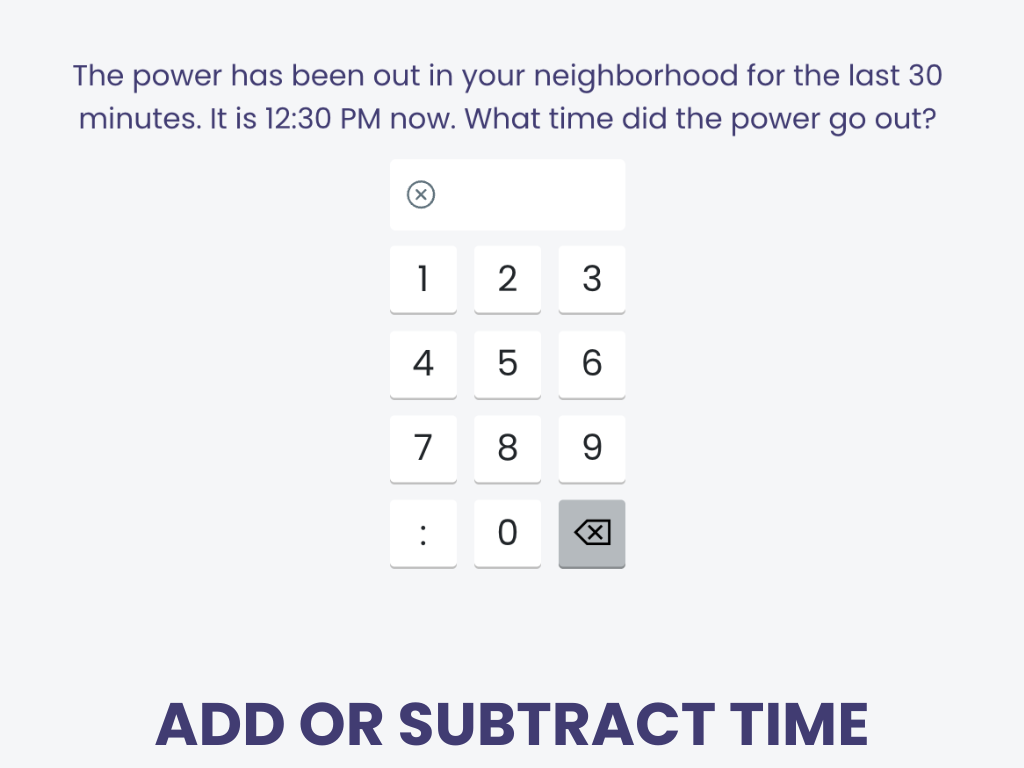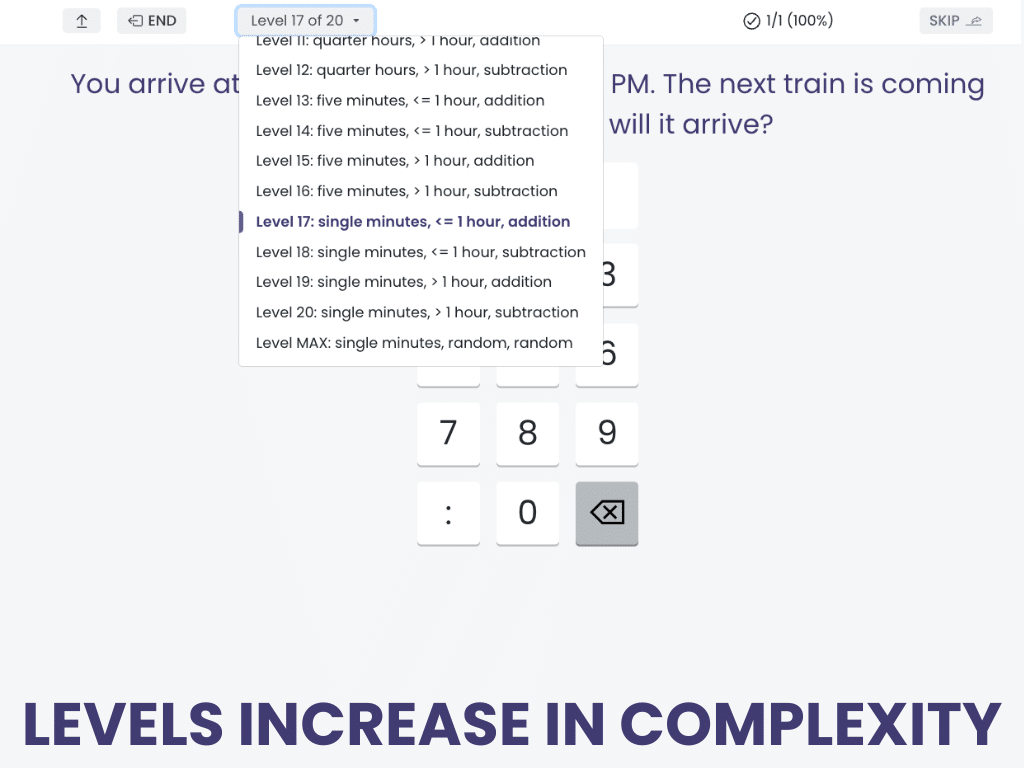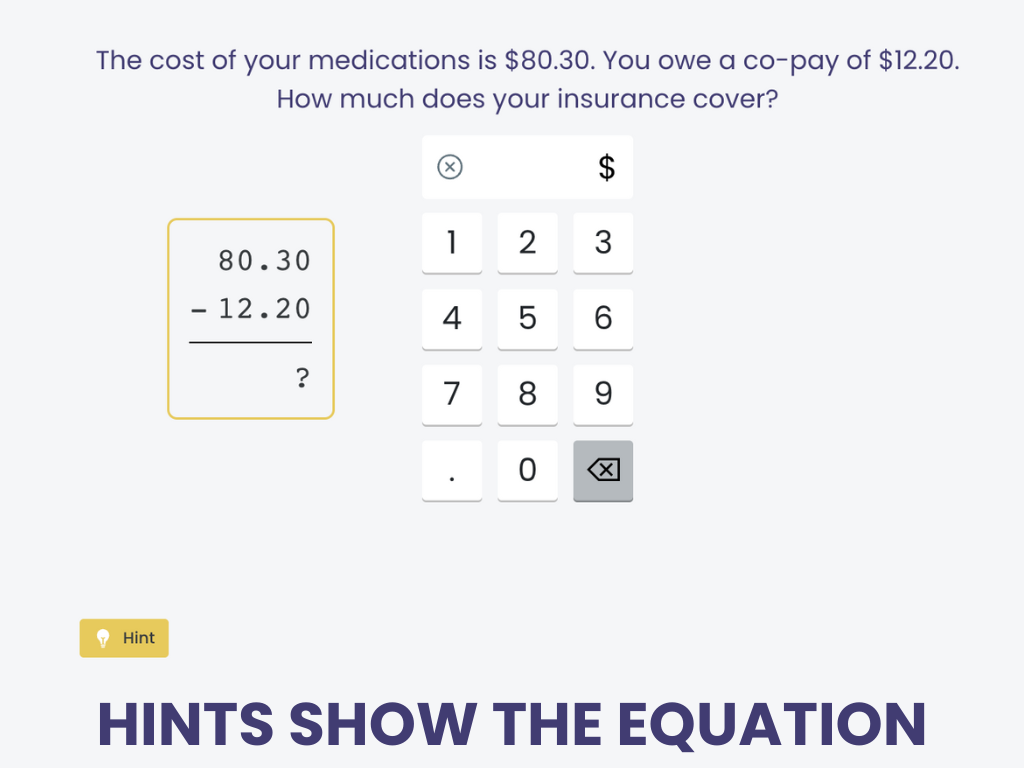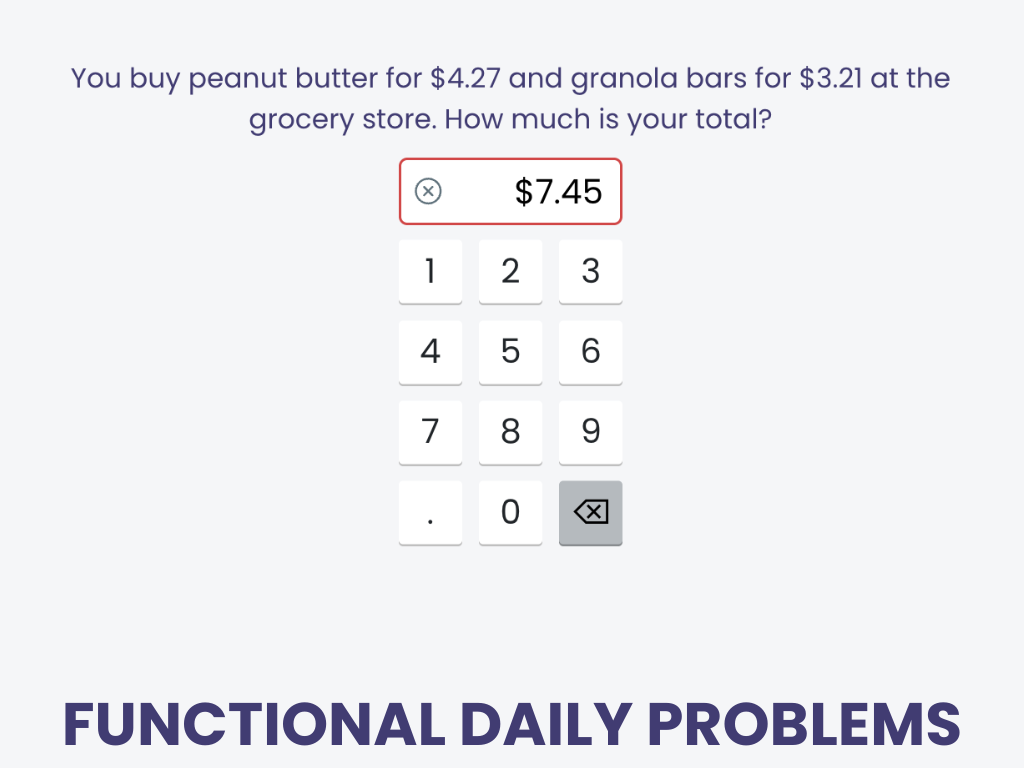What SLPs Need to Know:
Acalculia
10 min read
Numbers are everywhere; just look around you now. We use them constantly, often without noticing. A simple task like telling someone the time requires multiple steps involving language and cognition. In just a few seconds, your brain recognizes digits and symbols (7:00), converts them to a phonological representation (“seven”), and assigns meaning to them (not too late). This mental translation of numbers from one form to another is called transcoding.
So what happens when number processing and math calculations suddenly become a problem? Unfortunately, this is the often overlooked experience of individuals with a brain injury (e.g., stroke, TBI) or neurological disease. Acalculia or acquired dyscalculia isn’t a developmental disorder like you see in children. It’s a new deficit that affects independence in various daily living tasks.
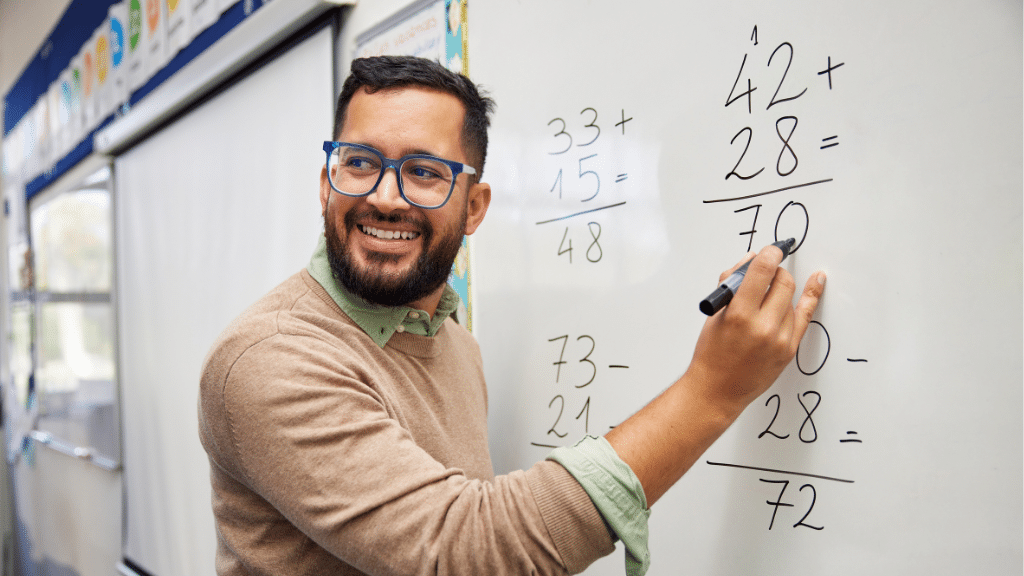
Ardila & Rosselli (2019) proposed two different classifications of acalculia:
- Aphasic acalculia: the result of a language impairment
- Alexic acalculia: difficulty reading numbers or math symbols
- Agraphic acalculia: difficulty writing numbers or math symbols
- Spatial acalculia: difficulty with visuospatial aspects of math, commonly associated with right hemisphere damage and left neglect
- Dysexecutive acalculia: often associated with frontal lobe damage and attention or working memory deficits
Acalculia & Aphasia
People with aphasia can present with a wide range of numerical deficits, including difficulty with counting, transcoding, math symbols, magnitudes, and simple-to-complex oral/written operations (Gonzalez et al., 2020). Single-digit addition is usually the easiest operation, but when double-digit problems or carrying get involved, people with aphasia have more difficulty than age-matched peers (De Luccia & Ortiz, 2016).
Gonzalez et al. (2021) found that individuals with mixed non-fluent aphasia and global aphasia showed the most severe calculation deficits compared to other aphasia subtypes. Individuals with Broca’s aphasia may have trouble with the number syntax (e.g., saying 1005 as 15 or 437 as 43007), whereas a person with Wernicke’s aphasia might have difficulty with lexical understanding (e.g. misinterpreting the number four for six) (Ardila & Rosselli, 2019).
Read more about the importance of numbers in daily life in this article.
In the Gonzalez study, people with aphasia who performed better on language tasks appeared to perform better on basic math tasks, suggesting overlap between language and number skills. This relationship wasn’t consistent across all aphasia types, and performance on nonverbal tasks also predicted calculation ability. Overall, the exact relationship between language and calculation skills remains unclear. What is evident, however, is that math difficulties can make everyday tasks significantly harder than clinicians or patients may realize.
Looking for Printable Handouts?
We’ve got you covered.
100+ high-quality, well-researched PDF handouts are available all in one place: The Tactus Virtual Rehab Center!
There are patient education handouts, strategy lists, a quick screener, & a summary of this article for quick reference – all about acalculia!
Sign up today for a risk-free 21-day trial of this innovative web-based therapy platform for SLPs.
Access 50+ evidence-based interactive digital treatments created specifically for adult medical speech pathologists.
The Functional Impact of Acalculia
People with acalculia have more trouble with activities of daily living involving numbers than their peers, like telling time, dialling phone numbers, using pin numbers and passwords, following recipes, handling money, managing finances, and navigating transportation (Benn et al., 2023; Proios et al., 2021). This can impact independence, emotional well-being, and confidence.
In an interview with people post-stroke (Benn et al., 2023), one participant stated:
“To me, the numbers you know the biggest problem … I get very upset. and I just feel that the…. If I had more help than that, that would be better…. I like I would like to be able to do, I don’t particularly want to do physics again, but I’d like my, you know, the Sudoku and (unclear speech). I wish. I wish I could do it again.”
Numeracy skills are also linked to the ability to understand health information and make informed decisions about care, like taking medications as recommended. (Peters et al., 2007; Reyna et al., 2009). Numbers show up in nearly everything we do, yet numeracy often goes unassessed. While time constraints and competing priorities are real, a quick screen at the very least can make the difference between a smooth recovery and unexpected obstacles.
Assessing Acalculia
It can be challenging to identify acalculia because baseline math skills vary across individuals. This also makes it hard to predict recovery. (Benn et al., 2023). There are free cognitive screeners that include very brief numeracy sections. The Oxford Cognitive Screen (OCS) includes more than a single math question, so it might be a better screening option than the Montreal Cognitive Assessment (MOCA) or the Saint Louis University Mental Status Exam (SLUMS), which only have one.
Arithmetic subtests can be found in the following language and cognitive assessment batteries, as mentioned by Cimino-Knight and colleagues (2002):
- Western Aphasia Battery- Revised (WAB-R)($$$)
- Boston Diagnostic Aphasia Examination (BDAE-3)($$$)
- Woodcock-Johnson (WJ V) ($)
- Wide Range Achievement Test (WRAT5)($$)
There are a few numeracy assessments described in research studies, but unfortunately, they are not formatted for easy use in clinical practice:
Since none of the readily available assessments are specific to calculation abilities, Semanza and colleagues (2014) designed a tool specifically for calculation abilities, called the Numerical Activities of Daily Living (NADL). Burgio et al. (2022) adapted the NADL into the NADL-Short (see supplementary file 3) for faster administration, which typically takes 15 minutes.
Clinicians can also informally probe different math areas to narrow down what to focus on in therapy (Zamarian et al., 2022), such as:
- Counting: Count items or dots on a page
- Transcoding: Write numbers to dictation and read numbers aloud, using both number words and Arabic numerals
- Basic calculations: Simple addition, subtraction, multiplication, and division problems in both oral and written formats
- Understanding numbers: Compare numbers (greater than/less than) and estimate quantities
- Serial subtraction: Subtract from 100 by 7’s to gauge attention and working memory
- Multi-digit calculations: Observe how the patient sequences steps and organizes their work during more complex equations
- Math word problems: Evaluate reading comprehension and the ability to extract relevant information from text-based problems
Finally, it’s important to ask patients how they used math in their daily lives before their brain injury and how those abilities have changed since. Understanding math use helps clinicians see the real-world impact of acalculia and prioritize meaningful, functional goals.
Keep in mind that patients may not immediately recognize a new math difficulty, especially if numbers weren’t a significant part of their routine (Benn et al., 2023). For some individuals, such as teachers, engineers, construction workers, or scientists, working with numbers is an integral part of their identity. Others may not think of themselves as “doing math” regularly, but numbers are without a doubt woven into their daily tasks, such as cooking, shopping, and time management.
Assessing Numeracy Skills
The Tactus Screener
Log in to the Virtual Rehab Center to download your PDF copy of the Tactus Numeracy Screener for a quick assessment.
Patient-reported number usage, transcoding, number skills, math calculations, working memory, and word problems – it’s all ready to go!
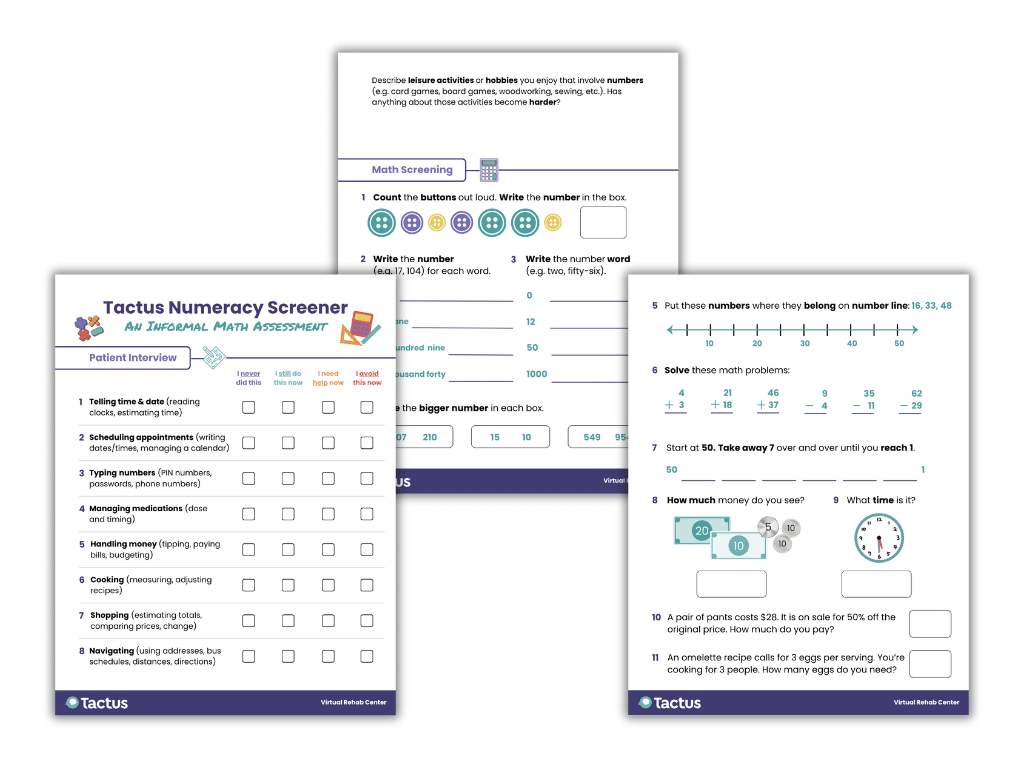
Once you know the deficits, you can dive into our interactive digital number treatments to start improving skills right away!
Sign up today for a risk-free 21-day trial of this innovative web-based therapy platform for SLPs.
Acalculia Treatment for Adults
Treatment approaches for acalculia vary depending on the subtype and overall goal. Speech-language pathologists can draw from both restorative and compensatory approaches, choosing activities that are meaningful to the patient’s life roles.
Treating Primary Acalculia
Relearning basic number concepts is the first step in treating primary acalculia (Ardila & Rosselli, 2019). Using a number line, drawings (e.g. dots, shapes), or physical manipulatives (e.g., poker chips, blocks, or buttons) can support understanding. The patient can practice counting objects, grouping items, and comparing sets to determine which group has more or less. Once the patient begins to understand number relationships, the clinician can progress to math calculations, gradually increasing their complexity.
Treating Aphasic Acalculia
Number words can be challenging for people with aphasia. Identifying and transcoding spoken number words (“/tu/”), written number words (two), and Arabic numerals (2) is a good place to start. Once the patient has mastered transcoding, the clinician may consider working on arithmetic fact knowledge (single-digit addition, subtraction, multiplication, and division), especially for people with fluent (or Werinicke’s) aphasia (Gonzalez et al., 2020).
Clinicians can use a drill-based approach, a conceptual approach, or a combination to improve math fact retrieval (Zamarian et al., 2022). The conceptual approach involves using backup strategies from residual knowledge, like solving a multiplication problem through adding (e.g. 3×5 = 5+5+5). Zamarian and colleagues (2022) referenced a 2003 study that found improvements in trained and untrained multiplication problems in a single subject with calculation deficits following conceptual training.
Patients can advance to more complex procedures that involve double digits, carrying, borrowing, decimals, and percentages (Gonzalez et al., 2020). The clinician can gradually add more language-heavy tasks as appropriate, while incorporating functional concepts like money, time, and measurements. It’s important to keep the patient’s personal goals in mind for person-centered therapy.
Drill Basic Facts
Mental Math: Addition
Mental Math: Addition is a multi-level digital treatment for acalculia inside the Tactus Virtual Rehab Center.
The drill-based format enables patients to develop skills for single digits, both with and without carrying.
Before starting, patients predict their performance and choose strategies. After completing, they reflect on their prediction and strategy usage.
Reports are generated for you with accuracy and time for each level.
Sign up today for a risk-free 21-day trial of this innovative web-based therapy platform for SLPs.
Treating Alexic Acalculia
Individuals with alexic acalcuia can perform mental math problems easily, but written problems pose a challenge. If writing skills are intact, patients can write numbers in the air to help recognize them (this is called kinetic writing). Talking about the visual elements of numbers and reconstructing written numbers (e.g., writing an 8 from a 3, or a 4 from a 1) can help patients differentiate numbers from one another (Ardila & Rosselli, 2019).
Treating Spatial Acalculia
A right hemisphere injury, particularly in the fronto-temporo-parietal region, can result in spatial deficits and difficulty with core arithmetic processes. Benavides-Varela and colleagues (2017) found that people with a right hemisphere injury struggled with number comprehension, transcoding, and written operations (especially subtraction and multiplication) compared to a control group of cognitively-intact adults.
Speech pathologists can target these spatially-impaired skills in therapy. If the patient presents with left neglect, clinicians can use the same strategies they would use in reading tasks, such as:
- using a visual anchor (i.e., a bright-colored line) on the left side of an equation or a math problem
- numbering the left and right margins
- finger-tracking to scan the page from left to right
- placing a hand on the left side, or feeling for the edge of the page as a tactile cue
Cues are gradually faded until the patient can use the learned strategies to solve math problems independently (Ardila & Rosselli, 2019). Note that spatial acalculia can impact non-paper-based number tasks as well, such as telling the time on a clock or counting coins. Visual anchors and tactile cues can be applied across multiple contexts to address these functional skills.
Treating Dysexecutive Acalculia
Attention and working memory (holding and manipulating information) significantly influence math performance, so these cognitive skills should be a primary focus of treatment in dysexecutive acalculia. One effective attention strategy is verbalization, which involves saying numbers aloud and talking through each step of a math procedure (Ardila & Rosselli, 2019).
Working memory can be addressed through tasks like backward digit span or serial subtraction. Finally, incorporating metacognitive strategies, such as the predict–perform procedure, can help patients recognize the need for compensatory techniques, which are beneficial for all subtypes of acalculia.
Use the Verbal Working Memory treatment inside the Virtual Rehab Center to work on backward digit span.
Examples of strategies include:
- Reduce distractions to stay focused
- Say numbers out loud to maintain attention and catch errors
- Write out the problem and steps instead of performing mental calculations
- Use a calculator for external support
- Take extra time to process the information
- Check over the procedures and answer to see if it makes sense
Many of these strategies promote self-monitoring to recognize mistakes in real time. It’s also important to encourage self-regulation, or the ability to think flexibly and adapt during the math task, like trying a different approach when one isn’t working. The patient should assess their performance afterwards to increase self-awareness and independence with numeracy.
Math in Everyday Life
Solving Time & Money Problems
Solve everyday time- and money-related problems with two treatments in the Tactus Virtual Rehab Center.
These realistic problems bring math to life for better motivation and carryover.
Each treatment has several levels requiring either addition or subtraction.
Patients must determine which operation to perform and then do so accurately.
Sign up today for a risk-free 21-day trial of this innovative web-based therapy platform for SLPs.
Final Thoughts on Acalculia
While few people associate speech therapy with numbers or math, numeracy is a critical part of daily life and communication that relies on a wide variety of language and cognitive skills. Speech-language pathologists are uniquely positioned to assess and treat acalculia with the same techniques as many other disorders, helping to improve independence and quality of life.
Learn More about Underlying Math Processes
If you’re interested in taking a deep dive into the internal calculation system, check out this article:
Zamarian, L., Delazer, M., & Semenza, C. (2022a). Arithmetic (re-)learning in neurological patients. Lernen Und Lernstörungen, 11(4).
